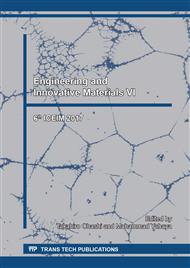p.261
p.267
p.275
p.280
p.286
p.292
p.297
p.302
p.307
Bio-Synthesis of Eicosapentaenoic Acid (EPA) from Palm Oil Mill Effluent Using Anaerobic Process
Abstract:
The supply of omega-3 fatty acids, which are EPA and DHA, was only 14.7% of the prospective demand calculated by using 500 mg/day/person as threshold limit for EPA and DHA consumption for a world population of 7.515 billion people. Alternative sources other than fish oil or seed-based-α linolenic acid (ALA) were necessary. Anaerobic digestion of palm oil mill effluent (POME) offered a new way for one of omega-3 fatty acids production, EPA. The digestion was conducted in anaerobic fluidized bed reactor supported by natural zeolite as the immobilization media. Process condition tried to be optimized was the pH level and the pre-treatment method (TSS filtration) before the digestion. Without any pre-treatment, the fatty acid profile produced after digestion contained considerable amount of polyunsaturated fatty acid with acidic condition provided higher EPA purity. On the other hand, pre-treatment led the digestion to produce saturated fatty acids with acidic condition provided very high purity of butyric acid as the product.
Info:
Periodical:
Pages:
286-291
Citation:
Online since:
January 2018
Price:
Сopyright:
© 2018 Trans Tech Publications Ltd. All Rights Reserved
Share:
Citation:


